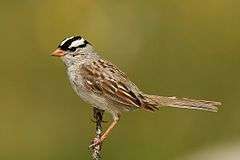Zonotrichia
Zonotrichia is a genus of five extant American sparrows of the family Passerellidae. Four of the species are North American, but the rufous-collared sparrow breeds in highlands from the extreme southeast of Mexico to Tierra del Fuego, and on Hispaniola.
| Zonotrichia | |
|---|---|
 | |
| White-crowned sparrow (Zonotrichia leucophrys) | |
| Scientific classification | |
| Kingdom: | Animalia |
| Phylum: | Chordata |
| Class: | Aves |
| Order: | Passeriformes |
| Family: | Passerellidae |
| Genus: | Zonotrichia Swainson, 1832 |
| Species | |
|
Z. leucophrys | |
Etymology
The genus name Zonotrichia is from Ancient Greek zone, "band", and thrix, trikhos, "hair.[1]
Species
The species in the genus Zonotrichia are:
| Image | Scientific name | Common Name | Distribution |
|---|---|---|---|
 | Zonotrichia leucophrys | White-crowned sparrow | North America |
 | Zonotrichia albicollis | White-throated sparrow | Canada and New England |
 | Zonotrichia atricapilla | Golden-crowned sparrow | north-central Alaska (including the Aleutian Islands as far west as Unimak Island) and central Yukon south to the northwestern corner of the US state of Washington, and wintering from southern coastal Alaska to northern Baja California |
 | Zonotrichia capensis | Rufous-collared sparrow | south-east of Mexico to Tierra del Fuego, and on the island of Hispaniola |
_(cropped).jpg) | Zonotrichia querula | Harris's sparrow | north part of central Canada (primarily the Northwest Territories and Nunavut, ranging slightly into northern Manitoba and Saskatchewan) |
These birds have brown backs streaked with black, and distinctive head markings. Their cup nests, built by the female, are of plant material lined with fine grasses and constructed on the ground, low in a tree or bush, or in a niche in a wall.
The female lays brown-blotched greenish-blue or greenish white eggs, which she incubates for 12–14 days. The male helps in feeding the chicks.
Zonotrichia sparrows feed on the ground on seeds, fallen grain, insects and spiders.
References
- Jobling, James A. (2010). The Helm Dictionary of Scientific Bird Names. London, United Kingdom: Christopher Helm. p. 414. ISBN 978-1-4081-2501-4.
- 900 m SW of Punta Hermengo at Fossilworks.org